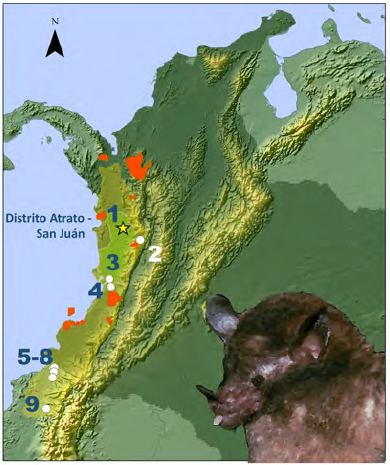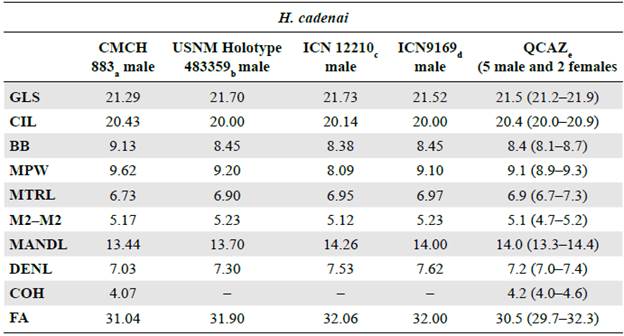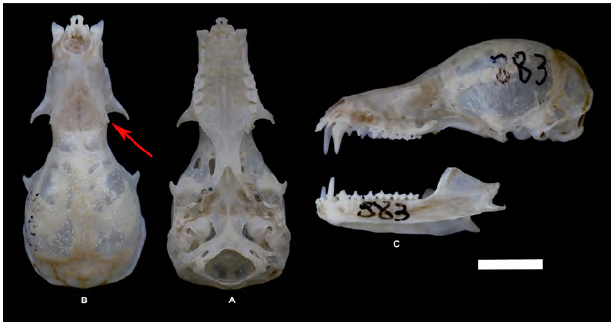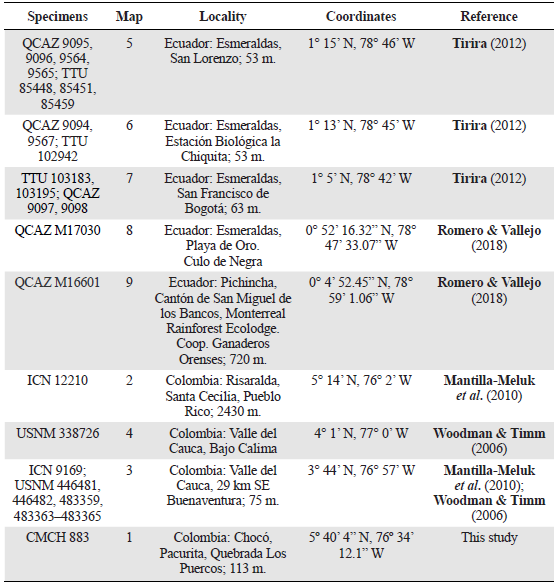Introduction
Hsunycteris (Parlos et al., 2014) is a Neotropical genus of nectarivorous bat belonging to the subfamily Lonchophyllinae (Phyllostomidae). This genus is distributed from Panama southward into South America where it occurs in Colombia, Venezuela, Guyana, Suriname, French Guiana, Brazil, Ecuador, Petó, and Bolivia (Parlos et al., 2014; Velazco et al., 2017). Four species are currently recognized within the genus: H. cadenai (Woodman & Timm, 2006), H. pattoni (Woodman &Timm, 2006), H. thomasi (Allen, 1904), and H. dashe (Velazco et al., 2017). Except H. dashe, the other three species of the genus occur in Colombia (Mantilla-Meluk et al., 2010; Ramírez-Chaves & Suárez-Castro, 2014; Velazco et al., 2017).
Bats of the genus Hsunycteris can be distinguished from the other genera in the subfamily Lonchophyllinae (Lionycteris, Lonchophylla, Platalina, and Xeronycteris) by the following combination of morphological characteristics: small size (greatest length of skull excluding the incisors (GLS): 19.5-22.5 mm, mandibular toothrow length (MANDL): 6.2-7.0 mm), the proximal section of the dorsal fur paler than the tips, absence of hairs on the dorsal region of the uropatagium, rostrum shorter than braincase, infraorbital foramen above the anterior root of the second upper premolar, first and second upper premolars elongated, and the central cusp of lower premolars not deflected labially (Velazco et al., 2017).
Hsunycteris cadenai is known only from a few records in museum collections of specimens recovered from some localities on the Colombian Pacific Coast and foothills of the Cordillera Occidental, and from northwestern Ecuador (Table 1). Here, we present the northernmost collecting locality for H. cadenai in the hyper-humid rainforest of the Colombian Central Chocó, as well as an updated map of the species distribution.
Materials and methods
On May 5, 2010 at 5:40 am, a male specimen of the genus Hsunycteris was collected in the site Quebrada Los Puercos (5°40'04" N, 76°34'12.1" W) (Figure 1) within the Área de Importancia para la Conservación de Murciélagos (Area of Importance for Bat Conservation) in Pacurita, Central Chocó (AICOM; A-CO-001), located in the Atrato-San Juan biogeographic district (Hernández-Camacho, et al., 1992), in the central portion of the Tumbes-Chocó-Magdalena Priority Terrestrial Ecoregion (Figure 1). The specimen was collected with a 12-meter-long mist net installed 12 meters above the ground in a well-stratified primary forest. The night before the capture, the temperature was 24.7 °C and the relative humidity was 100%.

Figure 1 Geographical distribution of Hsunycteris cadenai. Previous records are represented by circles and the new report by a star. Locality and coordinates of the numbers on the map are presented in table 1.
The specimen was preserved as a dry skin and a clean skull and deposited in the Colección Mastozoológica del Chocó, at Universidad Tecnológica del Chocó (CMCH 883). The fieldwork was part of the collecting efforts of the project: "Role of secondary forests (established through traditional selective logging) on bat diversity conservation at the Central Biogeographic Chocó Rainforest".
The taxonomic determination of the specimen was based on the verification of the diagnostic characters described for the species in Velazco, et al. (2017). Additionally, ten measurements were taken (nine craniodental and one external) also following Velazco et al. (2017): greatest length of skull excluding the incisors (GLS); condyle incisive length (CIL); braincase breadth (BB); mastoid process width (MPW); maxillary toothrow length (MTRL); width at M2 (M2-M2): greatest width of palate across labial margins of the M2s; mandibular toothrow length (MANDL); dentary length (DENL); coronoid height (COH), and forearm length (FA). The craniodental and external measurements were taken in millimeters (mm) with a digital caliper (0.05 mm of accuracy) (Table 2). To develop the updated distribution map of the species, we used georeferenced records from the literature (Woodman & Timm, 2006; Mantilla-Meluk et al., 2010; Tirira, 2012; Romero & Vallejo, 2018).
Table 2 Craniodental and external measurements of Hsunycteris cadenai. Measurements were taken from: a) this study, b) Woodman & Timm (2006), c and d) Mantilla-Meluk et al. (2010), and e) Tirira (2012).

Results
The specimen reported herein (CMCH 883) was identified as Hsunycteris cadenai based on the cranial, dental, and external morphological diagnostic characters of the species. Our specimen (CMCH 883) exhibits the lateral projections on the postorbital region (Figure 2), as well as a maximum length of the skull greater than 20.0 mm and a forearm length less than 34.5 mm (Table 2). The pelage of the specimen is short between the shoulders (6.7 mm); the dermal papillae on the chin are V-shaped and appear separated by a narrow basal cleft; it exhibits small outer upper incisors; the lingual cusp is developed in the second upper premolar; it has a weakly developed parastyle in the first upper molar, large and wide lower incisors, a well-developed notch in the paracristid of the first lower molar, and a wide hypoconid in the second lower molar.

Figure 2 Dorsal and ventral views of the skull and lateral view of the skull and mandible of Hsunycteris cadenai (CMCH 883). The red arrow indicates the lateral projection in postorbital region, a diagnostic characteristic of the species. Scale bar = 5mm
In table 2 we present the comparisons of the external and cranial measurements of our specimen (CMCH 883). Two of the cranial measurements of our specimen fall outside the range reported for the species (braincase breadth 9.13 mm and mastoid process width 9.62 mm); all the other measurements fall within the reported range documented for the species. Other external measurements of our specimen not presented in table 2 are total body length (53.43 mm), tail length (6.87 mm), ear length (10.36 mm), foot length (5.07 mm), tibia length (17.72 mm), tragus length (4.45 mm); length of the third metacarpus (31.38 mm), calcaneus length (6.19 mm), wingspan (225 mm), and weight (6.9 gr).
Hsunycteris cadenai is only known from five localities in Ecuador and four in Colombia (Table 1) including Pacurita (Chocó), as reported here, which constitutes the northernmost record for the species. In Colombia, the species ranges from 50 to 2,430 m while in Ecuador it occurs at elevations below 1,000 m. The species is distributed across different types of habitats including evergreen lowland forests in northwestern Ecuador (Tirira, 2012), mountainous sub-Andean forests above 2,000 m (Mantilla Meluk et al., 2010), and tropical and hyper-humid forests in Central Chocó, Colombia. This portion of the species distribution encloses some of the rainiest areas of the Colombian Biogeographic Chocó with precipitations above 12,000 mm/yr which are considered a hot spot of biodiversity and species endemism (Rangel et al., 2004). Interestingly, H. cadenai appears to be an endemic species of the Biogeographic Chocó with all known localities for the species within this biogeographic unit (Figure 1).
Our specimen was captured along with the following species: Artibeus lituratus (Olfers, 1818); Artibeusphaeotis (Miller, 1902); Artibeus watsoni Thomas, 1901; Carollia castanea Allen, 1890; Carollia perspicillata (Linnaeus, 1758); Carollia brevicauda (Schinz, 1821); Platyrrhinus helleri (Peters, 1866); Platyrrhinus dorsalis (Thomas, 1900); Rhinophylla alethina Handley, 1966; Uroderma convexum Lyon, 1902; Vampyressa thyone Thomas, 1909, and Vampyriscus nymphaea (Thomas, 1909).
Discussion
Bat nectivore forms provide important contributions to nature since they are responsible for the pollination of many unique Neotropical plant species, some of them with nocturnal flowering. In this context, the knowledge regarding pollinator agents of Chocó's vegetation, characterized by high levels of richness and endemism, is important for the design and implementation of conservation measurements. This new record of H. cadenai also represents an ecological extension for the species confirming its presence in the hyperhumid tropical rainforest (bp-T) of Chocó, which is characterized by precipitations above 12,000 mm/yr (Figure 1). The new record extends the distribution of the species to 224 km north of the type locality in Zabaletas River, Valle del Cauca (Woodman & Timm, 2006), and 75 km west of the nearest collecting locality in Santa Cecilia, Risaralda (Mantilla-Meluk, et al., 2010) (Figure 1).
Regarding its conservation status, the International Union for Conservation of Nature (IUCN) has classified H. cadenai as Data Deficient (DD) (Solari, 2018). Based on our intensive chiropteran sampling efforts in the region, we consider H. cadenai as a rare species, an observation also supported by Tirira (2012) for Ecuador. After more than ten years of continuous sampling in the area, here we introduce a record of the first H. cadenai specimen documented in the area. Given the high anthropogenic pressure in Chocó's forests in Colombia and in Ecuador forests and the apparent preference of H. cadenai for well-preserved primary forests, we recommend re-evaluating its conservation status. Additionally, H. cadenai should be considered as a focal species within the Pacurita Area of Importance for Bat Conservation (AICOM; A-CO-001), along with Rhinophylla alethina Handley, 1966; Choeroniscus periosus Handley, 1966, and Lionycteris spurrelli Thomas, 1913.
Although Colombia has one of the best-established systems of protected areas, its Pacific region is still underrepresented. An analysis of known museum records of H. cadenai in Colombia shows that only one collecting locality falls within an established protected area: the Tatamá National Natural Park, in the Atrato-San Juan biogeographic district (Figure 1). Biogeographic Chocó holds an extraordinary diversity of landscapes and ecosystems with an associated high environmental heterogeneity including a clinal variation of environmental variables such as temperature, relative humidity, evapotranspiration, and average annual precipitation, determining different types of vegetation covers and bat assemblages.
The AICOM Pacurita Chocó-Central is a key area for the protection of these bat species since the surrounding areas are under a high anthropogenic pressure, particularly mining and selective logging (Ramírez-Moreno & Ledezma-Rentería, 2007; Andrade-C, 2011; Valois-Cuesta & Martinez-Ruiz, 2016; UNODC, 2016; Mosquera-Andrade, 2014). However, AICOM lacks technical support under the Colombian legislation. It is urgent, therefore, to establish a protected area at the central portion of the Colombian Biogeographic Chocó. The Corporación Autónoma Regional para el Desarrollo del Chocó (CODECHOCÓ), which is the local government institution in charge of environmental surveillance and control, has promoted the creation of a regional conservation area in Chocó's Central Rainforest, the Cabí-Ichó Biological Corridor, which includes the town of Pacurita, i.e., the collecting locality where we recorded the presence of H. cadenai.
















